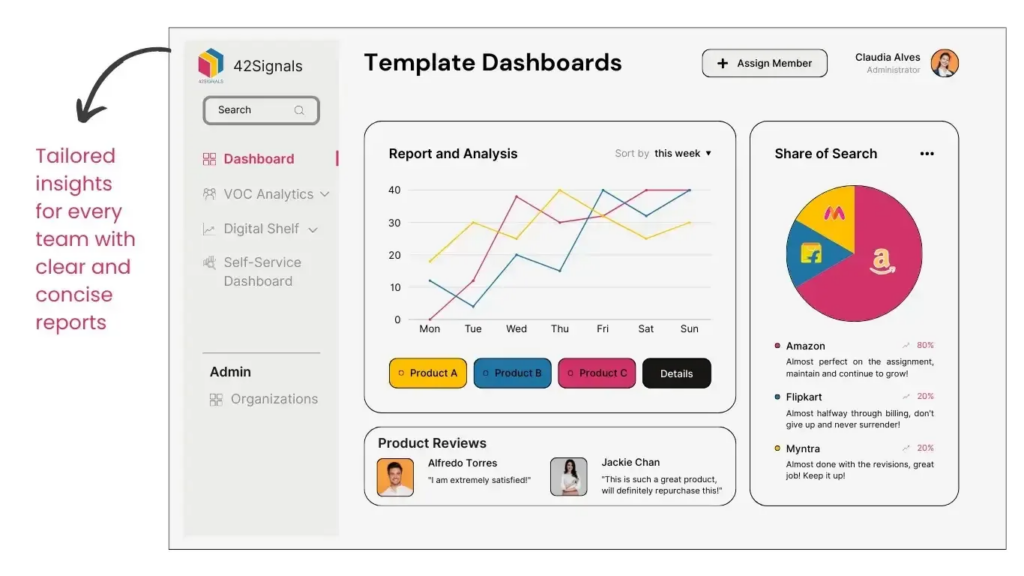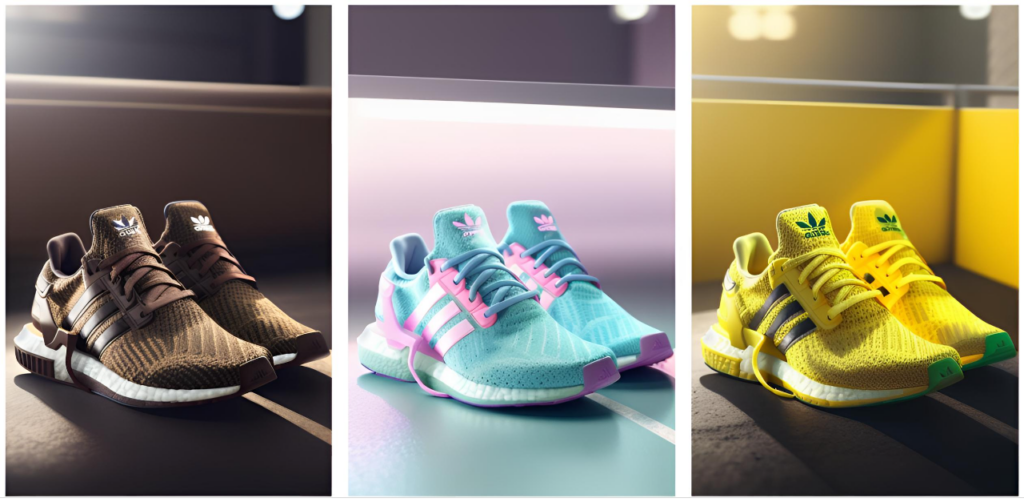Amazon stands as a titan that consistently redefines consumer behavior. With more than 310 million active customers and over 12 million products, Amazon offers sellers a massive platform to showcase their products to a global audience. However, amidst this sea of endless product choices, standing out is no small feat. While pricing, product descriptions, and customer reviews all play pivotal roles, Amazon product images often determine the success or failure of a listing.
How Do Amazon Product Images Influence Shopper Decisions?
Let’s understand why product images are critical for Amazon sales and whether AI-generated Amazon product images are a viable solution for sellers.

Image Source: Shopify
1. The Impact of Product Images on Buyer Behavior
When it comes to online shopping, customers can’t physically see or touch the product. This makes the product image the first impression a potential buyer gets.
In fact, 93% of consumers say that visual appearance is the key factor in purchasing decisions.
The role of Amazon product images goes beyond simply showcasing a product; they build trust, convey brand quality, and communicate the product’s value.

Image Source: Alicia Souza
Here’s why product images are critical:
- Builds Trust: High-quality images signal professionalism and credibility. Buyers trust sellers more when they see clear, detailed images that accurately represent the product.
- Visual Storytelling: Images can show the product in use, highlight key features, and offer different angles that help customers visualize themselves using the product.
- Reduces Returns: Accurate images reduce customer dissatisfaction, which in turn minimizes the rate of returns. Amazon’s A9 algorithm even considers the rate of returns while ranking products, making accurate product images a must for better ranking.
2. The Emergence of AI-Generated Product Images
The use of AI-generated product images is gaining traction among Amazon sellers.
By leveraging AI, sellers can produce images that are visually appealing, consistent, and optimized for Amazon’s guidelines.
But is AI the ultimate solution for product photography, or does it have limitations?
Benefits of AI-Generated Product Images…

Image Source: CreatorKit
AI can be a game-changer for product images in the following ways:
- Cost Efficiency: AI-generated images can be significantly more affordable than traditional photography, especially for sellers with large inventories. Once the model is trained, it can generate images for new products with minimal cost.
- Speed: AI can produce images faster than traditional methods. Sellers can quickly update product images for seasonal changes, promotions, or new features.
- Consistency: AI can create a uniform style across all product images, ensuring a cohesive brand image. This is especially useful for private label sellers who want to maintain a distinct brand identity.
- Enhanced Visuals: AI tools can enhance existing images, improve lighting, and remove backgrounds to ensure a professional appearance. AI can also create lifestyle images that show the product in real-world scenarios.
Drawbacks of AI-Generated Product Images
Despite its benefits, AI has its challenges:
- Accuracy Issues: AI-generated images might not capture the exact color, texture, or size of the product. This can lead to discrepancies that result in customer dissatisfaction.
- Regulatory Concerns: Some marketplaces, including Amazon, have specific guidelines regarding product images. Overly edited or AI-altered images might violate these rules, leading to penalties or delisting.
- Lack of Authenticity: Consumers often prefer seeing real, unedited images. AI-generated images can sometimes appear overly polished or artificial, which might deter some customers.
- Devaluation of Brand: Pictures that look obviously AI-generated may hamper sales due to unauthenticity.
3. Digital Shelf Analytics: Measuring the Effectiveness of Product Images
Digital shelf analytics refers to the tools and strategies used to analyze product visibility, rankings, and performance on digital platforms like Amazon.

It helps sellers understand how Amazon product images contribute to visibility, clicks, conversions, and other performance metrics.
Here’s how digital shelf analytics comes into play:
- Share of Search: This metric indicates how often a product appears in search results compared to competitors.
High-quality images can improve click-through rates (CTR), which in turn positively impacts the share of search.
- Product Detail Page Optimization: Digital shelf analytics can help sellers identify if their Amazon product images align with high-performing keywords and if they are driving conversions.
For instance, a high bounce rate may suggest that the images aren’t engaging or informative enough.
- Conversion Rate Tracking: Sellers can use e-commerce analytics to see how different images impact conversion rates.
By conducting A/B testing, they can determine whether lifestyle images, AI-generated images, or real photographs perform better in driving sales.
4. E-commerce Analytics: The Bigger Picture
E-commerce analytics extends beyond individual product listings to provide a comprehensive view of the entire sales funnel, from ad campaigns to product page performance.

Good product images influence various aspects of e-commerce analytics:
- Ad Spend Efficiency: High-quality images increase the CTR of ads. When product images align with ad visuals, it results in a smoother user journey and better conversion rates. This leads to more efficient ad spend.
- Customer Engagement: The quality of Amazon product images directly impacts user engagement metrics like time spent on the product page, the number of images viewed, and scroll depth.
E-commerce analytics helps sellers understand which images perform best, allowing them to refine their strategies.
- Return on Investment (ROI): Product images contribute to higher conversion rates, which means a better ROI on marketing campaigns.
By monitoring e-commerce analytics, sellers can see how much their investment in product images contributes to overall sales and profit margins.
5. Balancing AI and Human Touch in Product Images
While AI-generated images offer speed, consistency, and cost-effectiveness, human creativity still plays a critical role.
The best strategy often involves a hybrid approach where AI assists in creating base images, but human intervention ensures authenticity, accuracy, and adherence to Amazon’s guidelines.

Image Source: Segmind
Here’s how to balance AI and the human touch:
- Start with AI for basic images like packshots, angles, and plain backgrounds. This approach speeds up the process and ensures uniformity.
- Add human touches for lifestyle images, in-context shots, and special scenarios that require more nuance. Human photographers can add elements of spontaneity and emotion that AI may lack.
- A/B test the combination of AI-generated and human-touched images to understand which blend works best for your audience.
For instance, lifestyle images generated by AI might be more cost-effective, but actual photos of the product in use could drive more engagement.
6. Best Practices for Amazon Product Images

Image Source: Reddit
To ensure Amazon product images are optimized for better sales, here are some best practices:
- Use High-Resolution Images: Amazon recommends at least 1,000 pixels on the longest side to enable zoom functionality, a key factor in conversion.
- Show Multiple Angles: Offer a complete view of the product by including images from various angles. This helps customers get a better idea of the product.
- Incorporate Lifestyle Images: Show the product in use to help customers visualize it in their daily lives. AI can assist in creating these images, but authenticity is key.
- Highlight Key Features: Use close-ups to emphasize unique features, textures, or any special design elements.
- Maintain Consistency: Ensure that all images maintain a consistent style to build brand recognition and improve overall aesthetic appeal.
Conclusion
Amazon Product images are a crucial element of Amazon sales, impacting everything from conversion rates to share of search and ad spend efficiency.
While AI can help in image generation, consideration should be given to its actual interpretation so the images don’t look fake and devalue the brand.
In the end, whether to “AI or not to AI” should depend on how well it aligns with your brand’s image, customer expectations, and overall business goals.
Looking to optimize your Amazon product listings with insights on image performance and digital shelf analytics? Schedule a demo with us today!




